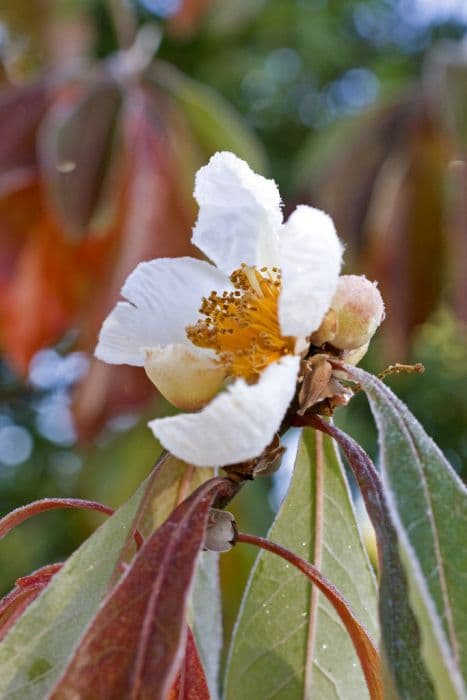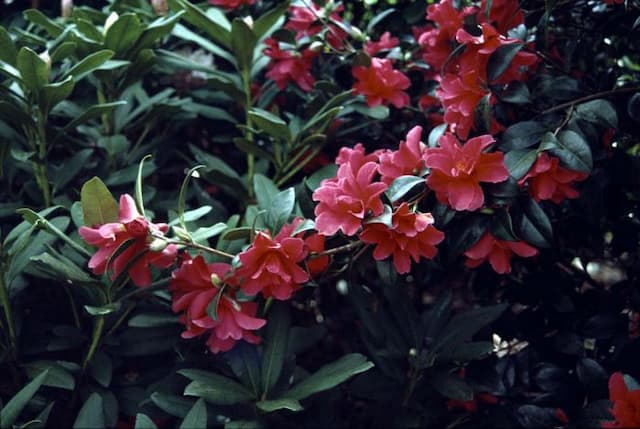Franklin tree Franklinia alatamaha

ABOUT
Franklinia alatamaha is the only species in this (monotypic) genus. It is a deciduous small tree or large shrub, 3-4.5m, with dark green, glossy, simple oblong leaves, to 18cm long, turning crimson in autumn. Flowers are large, to 6cm across, cup-shaped, snowy white with a large boss of yellow stamens, in autumn. Fragrant, and can flower with the autumn leaf colour, but blooms are only produced after a long, hot summer
About this plant
 Names
NamesFamily
Theaceae
Synonyms
Franklin Tree, Ben Franklin Tree, Lost Camellia
Common names
Franklinia alatamaha.
 Characteristics
CharacteristicsLife cycle
Perennials
Foliage type
Deciduous
Color of leaves
Green
Flower color
White
Height
10-20 feet (3-6 meters)
Spread
6-10 feet (1.8-3 meters)
Plant type
Tree
Hardiness zones
5-8
Native area
Southeastern United States
Benefits
 General Benefits
General Benefits- Ornamental Value: Franklinia alatamaha, commonly known as the Franklin tree, features showy, fragrant white flowers with bright yellow centers, providing visual interest in gardens and landscapes.
- Historical Significance: The plant holds historical importance as it was discovered by John Bartram and named after Benjamin Franklin; growing it can be seen as preserving a piece of botanical history.
- Habitat for Wildlife: The Franklin tree provides nectar for pollinators, such as bees and butterflies, and may serve as a food source for various bird species.
- Seasonal Appeal: It offers year-round interest with flowers in the summer, vibrant foliage in the autumn, and persistent seed capsules through winter.
- Rarity and Conservation: As an extinct-in-the-wild species, planting Franklinia alatamaha contributes to its conservation and can raise awareness about plant conservation efforts.
- Educational Interest: The unique story of the Franklin tree's discovery and subsequent extinction in the wild provides an educational narrative for botanical gardens and conservation programs.
 Medical Properties
Medical PropertiesThis plant is not used for medical purposes.
 Air-purifying Qualities
Air-purifying QualitiesThis plant is not specifically known for air purifying qualities.
 Other Uses
Other Uses- Art and Illustration: Franklinia alatamaha is often used as a subject in botanical art and drawings due to its striking white flowers and historical significance.
- Conservation Education: The plant serves as an emblem for plant conservation due to its extinction in the wild, highlighting the importance of preserving biodiversity.
- Cultural Significance: It carries historical value for its association with early American botanists and is sometimes used in historical gardens and period landscapes.
- Memorial Gardens: Because of its rarity and beauty, Franklinia alatamaha is planted in memorial gardens as a tribute to lost species and as a symbol of remembrance.
- Botany Study: It is an interesting subject for botany students to study due to its unique history and the mystery surrounding its extinction in the wild.
- Habitat Creation: When planted in suitable areas, the Franklinia alatamaha can help to create a habitat for pollinators like bees and butterflies.
- Collector's Item: Enthusiasts and plant collectors may grow Franklinia alatamaha as a rare and prized addition to their plant collections.
- Theme Gardens: This plant is often included in native plant gardens or colonial-themed landscapes to represent the flora of early America.
- Photography: Because of its attractive blooms, the Franklinia alatamaha is a popular subject for photographers, especially when in full bloom.
- Fragrance Extraction: While not commonly used for this purpose, the flowers of Franklinia alatamaha could potentially be used to extract natural fragrances for perfumery or aromatherapy.
Interesting Facts
 Feng Shui
Feng ShuiThe Franklin tree is not used in Feng Shui practice.
 Zodiac Sign Compitability
Zodiac Sign CompitabilityThe Franklin tree is not used in astrology practice.
 Plant Symbolism
Plant Symbolism- Rarity: The Franklin tree is known for its rareness, as it no longer exists in the wild and is only found in cultivation. It symbolizes something precious and unique that must be preserved and cherished.
- Survival: Since the Franklin tree has survived only through cultivation after it disappeared from its natural habitat, it represents resilience and the ability to overcome difficult circumstances.
- Historical Legacy: Named after Benjamin Franklin, the tree carries a sense of historical significance and is often associated with the legacy of the past and the influence that continues into the present.
- Conservation: As a species saved from extinction through human efforts, the Franklin tree symbolizes the importance of conservation and environmental stewardship.
- Beauty and Fragility: The delicate white flowers of the Franklin tree are breathtaking yet fleeting, representing the transient nature of beauty and life's ephemeral qualities.
 Water
WaterThe Franklin tree requires regular watering to maintain moist soil, especially during its first few years to help establish a robust root system. Water the Franklin tree thoroughly once a week, making sure that the soil is soaked to a depth of several inches. During hot, dry periods, you may need to increase watering frequency to twice a week. It's important to provide about 1 to 2 gallons of water each time, depending on the size and maturity of the plant. Avoid overwatering, as the Franklin tree does not tolerate waterlogged soil conditions.
 Light
LightThe Franklin tree prefers full sun to partial shade, thriving best with at least four to six hours of direct sunlight daily. Place the plant in a spot where it can receive ample morning sunlight and some afternoon shade, as this will promote optimal growth and flowering. Avoid deep shade areas, as insufficient light can lead to sparse foliage and reduced flowering.
 Temperature
TemperatureThe Franklin tree performs well in a temperate climate and can tolerate temperatures ranging from approximately 20°F to 100°F. However, the ideal temperature range for this plant is between 60°F and 80°F. It's essential to protect the Franklin tree from extreme cold, as temperatures below 20°F can damage or kill the plant.
 Pruning
PruningPrune the Franklin tree to maintain its shape and encourage healthy growth. Pruning should be done in late winter or early spring before new growth begins. Remove any dead or damaged wood and thin out crowded branches to improve air circulation. Light pruning each year is usually sufficient, but avoid heavy pruning, which can stress the tree.
 Cleaning
CleaningAs needed
 Soil
SoilThe Franklin Tree thrives in acidic, well-drained soil, with an ideal pH range of 5.5 to 6.5. A soil mix containing peat, pine bark, and perlite or coarse sand in equal parts can create a suitable growing medium for this plant, ensuring good drainage and the right acidity.
 Repotting
RepottingFranklin Trees don't require frequent repotting; they should be repotted every 2-3 years or when they outgrow their current container. It's best to repot in spring before the onset of new growth.
 Humidity & Misting
Humidity & MistingFranklin Trees prefer moderate humidity levels; however, they are adaptable and can tolerate lower indoor humidity. Aiming for a relative humidity of around 40-50% is generally beneficial for the plant's health.
 Suitable locations
Suitable locationsIndoor
Provide bright indirect light, acidic soil, and ensure moderate humidity.
Outdoor
Plant in acidic soil, sun to partial shade, protect from strong winds.
Hardiness zone
5-8 USDA
 Life cycle
Life cycleThe Franklin tree (Franklinia alatamaha) begins its life cycle when its seeds germinate, typically requiring a period of cold stratification to break dormancy. Upon germination, the seedlings grow into small shrubs, developing a strong root system and foliage. As it matures, the shrub transitions to a small tree phase, where it starts to develop the characteristic white, fragrant flowers in late summer to early fall, which are pollinated by insects. After pollination, the flowers develop into woody capsules containing many seeds, which, when mature, are naturally dispersed or collected for cultivation. The Franklin tree can live for several decades, although it is susceptible to root diseases which can shorten its lifespan. It continues to grow and reproduce annually, creating a cycle of flowering and seed production within its preferred habitat.
 Propogation
PropogationPropogation time
Spring-summer
Propogation: The Franklin tree, scientifically named Franklinia alatamaha, is typically propagated through seed during autumn or through semi-hardwood cuttings taken in summer. The most popular method of propagation for the Franklin tree is by seed. Once the seed capsules mature in autumn, they are collected and the seeds are extracted. The extracted seeds require a period of cold, moist stratification for about 60 to 90 days at 40 degrees Fahrenheit (4.4 degrees Celsius) to break dormancy. Subsequently, the seeds are sown in a well-drained seed-starting mix, lightly covered with soil, and kept consistently moist. It is crucial to maintain a temperature of 70 to 75 degrees Fahrenheit (21 to 24 degrees Celsius) for successful germination. Seedlings are allowed to grow until large enough to be transplanted into individual pots or into the garden.









